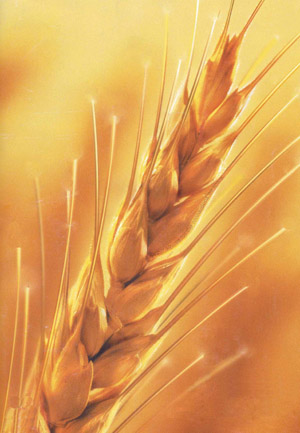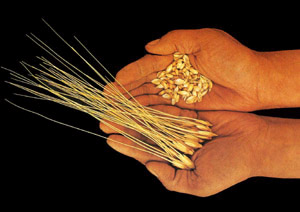

Traditionally wheat has been consumed only in the way of bread; more specifically, sourdough bread. This meant baking with a viable sourdough culture that incorporates the natural leavening of the bread with a pre-fermented starter developed from wild yeast, and beneficial bacteria. Most importantly, the microorganisms or bacteria, would, through fermentation, predigest the wheat and contribute to a more easily digestible product for human consumption.

Through the isolation of yeast in the 19th Century, it paved the way to a much more convenient way of baking. Chemical additives like tartaric acid or potassium bicarbonate further undermined the need for a natural leaven. Physical introduction of air through whipping it in or using sheeting methods to introduce large amounts of fat to physically raise the dough, as in puff pastries, has opened up a whole new pallet of products made from wheat. In our highly industrialized world, there are even more products like breakfast cereals where, through diverse processes, a crunchy product is made for the modern diet. Add to this milk that has been sterilized and homogenized and it is no wonder that if we burden our digestive system for an extended time to these unnatural foods it throws up its arms, and we become sensitive to, or even severely allergic or sick to the point of not being able to function anymore. For example, look at Cohen's celiac disease.

We cannot afford to loose this important, basic food ingredient through folly or the exploitation of what seduces our senses. Overindulgence in products devoid of any microbial beneficial organisms is a sure way of the eventual destruction of our capability to digest these wheat-related modern foods.

Food allergies are dramatically on the rise, and dietitians treat the symptoms, but not the underlying true causes, which is the modern day diet. Avoidance gives temporary relief, but is no cure. What we need to do is go back to our roots and what has kept us healthy for thousands of years and let the human species flourish. Our founding of civilization rests solely on an agricultural basis, largely on the cultivation of wheat and other grains.

The most fascinating fact about wheat is that, through a phenomenal occurrence in nature, where two hybrid forms of wheat, miraculously combined to give us the plum-shaped kernel, This helped sustain civilized man throughout the past ages. Here is a description of this occurrence by J. Bronowski in his book "The Ascent Of Man".

The turning-point to the spread of agriculture in the Old World was almost certainly the occurrence of two forms of wheat with a large, full head of seeds. Before 8000 BC wheat was not the luxuriant plant it is today; it was merely one of many wild grasses that spread throughout the Middle East. By some genetic accident, the wild wheat crossed with a natural goat grass and formed a fertile hybrid. That accident must have happened many times in the springing vegetation that came up after the last Ice Age. In terms of the genetic machinery that directs growth, it combined the fourteen chromosomes of wild wheat with the fourteen chromosomes of goat grass, and produced Emmer with twenty-eight chromosomes.

That is what makes Emmer so much plumper. The hybrid was able to spread naturally, because its seeds are attached to the husk in such a way that they scatter in the wind.

 For such a hybrid to be fertile is rare but not unique among plants. But now the story of the rich plant life that followed the Ice Ages becomes more surprising. There was a second genetic accident, which may have come about because Emmer was already cultivated. Emmer crossed with another natural goat grass and produced a still larger hybrid with forty-two chromosomes, which is bread wheat. This was improbably enough in itself, and we know now that bread wheat would not have been fertile but for a specific mutation on one chromosome. For such a hybrid to be fertile is rare but not unique among plants. But now the story of the rich plant life that followed the Ice Ages becomes more surprising. There was a second genetic accident, which may have come about because Emmer was already cultivated. Emmer crossed with another natural goat grass and produced a still larger hybrid with forty-two chromosomes, which is bread wheat. This was improbably enough in itself, and we know now that bread wheat would not have been fertile but for a specific mutation on one chromosome.

Yet there is something even stranger. Now we have a beautiful ear of wheat, but one which will never spread in the wind because the ear is too tight to break up. And if I do break it up, why, then the chaff flies off and every grain falls exactly where it grew. Let me remind you, that is quite different from the wild wheats or from the first, primitive hybrid, Emmer. In those primitive forms the ear is much more open, and if the ear breaks up then you get quite a different effect - you get grains which will fly in the wind. The bread wheats have lost that ability. Suddenly, man and the plant have come together. Man has a wheat that he lives by, but the wheat also think that man was made for him because only so it can be propagated. For the bread wheats can only multiply with help; man must harvest the ears and scatter their seeds; and the life of each, man and the plant, depends on the other. It is a true fairy tale of genetivs, as if the coming of civilization had been blessed in advance by the spirit of the abbot Gregor Mendel.

We are tied to our environment much more than we ever thought. It is like we grew up with wheat together, but through modern foods we have distanced ourselves from the very grain that made us, by denaturing it to the point of becoming allergic to it. For thousands of years it has fed us and stilled our hunger, but only in the past half a century are we showing signs of allergies towards it, because of those changes. It is mandatory that we return to a diet that emphasis the microbial aspect of our foods lest we all get allergic to a food that is vitally important in our ancestral diet. |
